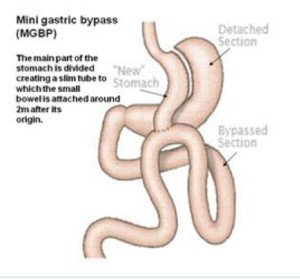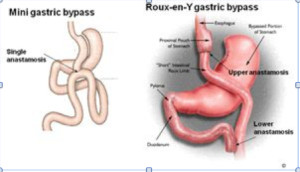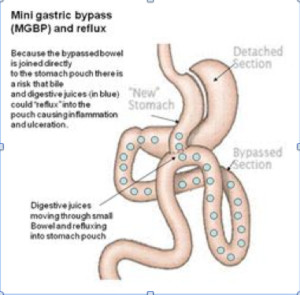[vc_row][vc_column width=”1/1″][vc_column_text]
One Anastomosis Gastric Bypass (OAGB) /Omega Loop Gastric Bypass Surgery
[/vc_column_text][vc_video link=”https://www.youtube.com/embed/MdLxOAGVEnY”][vc_row_inner][vc_column_inner width=”2/3″][vc_column_text]
Omega Loop Gastric Bypass (Mini) – The Effective Alternative to Standard Gastric Bypass Surgery
Omega Loop Gastric Bypass surgery, (also known as Mini Gastric Bypass surgery) is very similar to the Roux-en-Y Gastric Bypass procedure. As with the standard Roux-en-Y Gastric Bypass surgery, the Mini Gastric Bypass (MGBP) works by restricting the amount of food that can be eaten at any one time and by altering gut hormones involved in appetite control.
OAGB was first used in the late 1960s but was abandoned in the 1970s. Today, because of developments in laparoscopic (“keyhole”) surgery, OAGB has started to come back into fashion and is being promoted as a quick and effective alternative to standard gastric bypass.[/vc_column_text][/vc_column_inner][vc_column_inner width=”1/3″][vc_column_text] [/vc_column_text][/vc_column_inner][/vc_row_inner][/vc_column][/vc_row][vc_row][vc_column width=”1/1″][vc_column_text]
[/vc_column_text][/vc_column_inner][/vc_row_inner][/vc_column][/vc_row][vc_row][vc_column width=”1/1″][vc_column_text]
How is the Operation Performed?
One Anastomosis Gastric Bypass (OAGB) surgery is considered to be a relatively quick and simple operation to perform.
In the first part of One Anastomosis Gastric Bypass (OAGB) surgery, an endoscopic stapler is used to divide the stomach into two parts, and a new, narrower stomach pouch is formed. Because the new stomach is much smaller, it will hold much less food.
The larger part of your stomach will remain in the body and continue to produce digestive juices to help with digestion. However, this detached portion of the stomach will no longer come in contact with food.
Once the new stomach is formed, the surgeon brings up a 2-meter loop of bowel consisting of the duodenum and part of the jejunum, and this new bypass point is joined to the lower part of the stomach pouch. The joining of bowel to bowel, or stomach to bowel, is called an anastomosis.
By bypassing 2 meters of the small intestine, the food passes from the small stomach pouch directly into the small bowel where it meets the digestive juices from the detached portion of the stomach.
By bypassing the duodenum and the jejunum, food and calorie absorption is reduced. Fewer calories absorbed translates to weight loss. The fact that digested food can bypass a large portion of the bowel and directly enter the small bowel means that the so-called “alimentary limb” is non-existent and hence food will directly go into the so-called “common channel.”
Recovery from Omega Loop Gastric Bypass
Patients can often expect to recover from this surgery within 24 hours. However, it’s best to expect to stay in hospital for 3 to 5 days. Patients will be encouraged to get up and move around as soon as possible to prevent any blood clots developing.
You can expect to start out on a liquid diet after your surgery and slowly transition onto solids as the body adjusts to the changes resulting from the surgery.
How Does One Anastomosis Gastric Bypass (OAGB) Differ from the Standard Bypass?
The main difference between the standard Roux-en-Y Gastric Bypass surgery and the Mini Gastric Bypass (MGBP) can be seen by comparing the two diagrams below.
In the Omega Loop Gastric Bypass there is only one anastomosis between the new stomach and the bowel bypass point, whereas in the Roux-en-Y Gastric Bypass procedure, there are two – an upper and a lower anastomosis. Because of this, the MGBP can be completed in less time than the RYGBP and – at least theoretically – with fewer early complications.
Because the stomach pouch is created on the lower curvature of the stomach and there is only one anastomosis, the procedure is also easily reversible if needed, unlike the Roux-en-Y Gastric Bypass.
When it comes to weight loss results, studies show that weight loss and health benefits resulting from mini gastric bypass are essentially the same as results seen from the standard Roux-en-Y Gastric Bypass.

The main difference between the standard Roux-en-Y gastric bypass procedure (RYGBP) and theOne Anastomosis Gastric Bypass (OAGB) can be seen by comparing the two diagrams opposite. It is clear that in the case of the OAGB there is only one anastomosis, whereas in the RYGBP there are two – an upper and a lower.
Because of this the OAGB can be done in less time than the RYGBP and – at least theoretically – with fewer early complications.
Studies show that weight loss and health benefits resulting from mini gastric bypass are essentially the same as for standard Roux-en-Y gastric bypass.
How One Anastomosis Gastric Bypass (OAGB) Delivers Weight Loss Results
This gastric bypass procedure can help achieve your weight loss goals in a number of ways:
• The mini stomach formed in this procedure can hold much less food, causing the patient to feel fuller quicker.
• The body absorbs fewer calories because food no longer passes through the duodenum and the jejunum.
• The surgery will cause hormone levels that regulate your appetite to change, thus suppressing your appetite.

What are the Advantages of OAGB?
There are many reasons why patients and surgeons choose the Omega Loop Gastric procedure. Here are some of the major benefits this surgery can provide:
• The weight loss resulting fromOne Anastomosis Gastric Bypass (OAGB) surgery is similar to the Roux-en-Y procedure with 30-40% body weight loss expected.
• There is a shorter surgery and recovery time compared to other Gastric Bypass procedures.
• The operation is easily reversible, and patients are often pleased with the weight loss results they receive after undergoing this surgery.
Because of these benefits making One Anastomosis Gastric Bypass (OAGB) surgery simple, safe and effective, the popularity of this weight loss surgery option is increasing.
Are there any disadvantages to the OAGB?
Bile Reflux Gastritis – There is one potentially serious problem withOne Anastomosis Gastric Bypass (OAGB) surgery. Because the pouch is small and joined close to the flow of digestive juices, it is possible for these juices to “reflux” up into the stomach pouch causing erosion, inflammation, and painful ulceration.
It must be said that most of the recent studies do not seem to report this as being much of a problem in practice, but if it occurs it can be difficult to deal with. This anastomosis is usually constructed over 2m mark down the small bowel, which not only creates a good reduction in absorbing calories but also prevents the unwanted biliary reflux.
Mineral and Vitamin Deficiencies – There is also a risk of mineral and vitamin deficiencies developing due to a section of the intestine being bypassed in the procedure.
So is the OAGB preferable to the standard bypass?
At present, the short answer is it is uncertain.One Anastomosis Gastric Bypass (OAGB) surgery is quicker because it is a single stage procedure, but in practice and inexperienced hands the time difference is not great. But with our experienced and highly trained surgeons performing the procedure, you can trust you are in capable hands.
There is some preliminary evidence to show that the early complication rate of OAGB is lower than that for RYGBP, but operative mortality is the same. Moreover, short-term weight loss is virtually the same for both. So whether you wish to pursue Roux-en-Y Gastric Bypass surgery orOne Anastomosis Gastric Bypass (OAGB) surgery, either option is bound to deliver the weight loss results you need.
Contact Lap Surgery Brisbane about One Anastomosis Gastric Bypass (OAGB)
To determine whether you’re suitable forOne Anastomosis Gastric Bypass (OAGB) surgery, please enter your details into our BMI Calculate to show your Body Mass Index.
Once your BMI is determined, contact us and we can advise if your BMI meets the threshold for this surgery. Please call us on (07) 3353 9694 to discuss your Omega Loop Gastric Bypass surgery options. You may also fill out our online weight loss surgery registration form.[/vc_column_text][/vc_column][/vc_row]